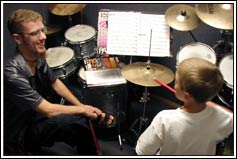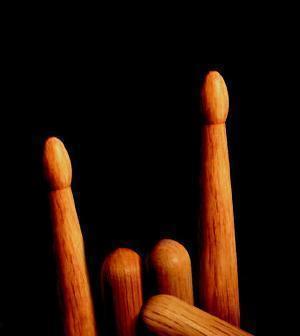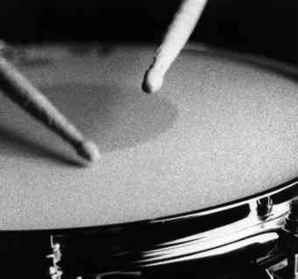




Aaron Bland .com


Goal Setting
It is important to know why you are practicing something. The general answer is usually, "to get better". Try to set specific goals at the beginning of each week or even each practice session. I want to:
-be able to play an exercise with good technique.
-be able to repeat an exercise 4 times, 10 times without stopping, etc.
-be able to play a page of patterns 4 times each, with transitions to the next pattern.
-be able to play a piece of music from beginning to end.
-be able to play a piece of music with a metronome.
-be able to play a piece at a specific tempo. (120 beats per minute, 125 bpm, 130 bpm, etc.)
-memorize a piece of music.
-be able to perform a song for an audience.
By setting specific goals, you can track your progress and recognize marks of improvement.
Technique Analysis
Start with your grip. Whether you are using traditional or matched grip certain principles will remain true. Every once in a while, check out your technique. Run through the checklist:
-Sit or stand with your back straight, and feet, about a shoulder's distance apart.
-Elbows slightly spaced from the body -If sitting, have your knees at about a 90 degree angle
-Playing surface is table-top or tilted slightly toward you at approximately belt buckle height.
-Fulcrum secured and poised for play about 1/3 of the way up the stick.
-Fulcrum grip is firm enough to maintain control of the stick, but relaxed enough to allow it to move.
-Fingers in proper position and in line with the stick.
-Hands should be palm down when using matched grip to allow your wrists to hinge up and down.
-Wrist, fingers and arm are working together to maintain control of the stick.
-Angle of sticks should be about 90 degrees from each other, slightly more for traditional grip.
-Distance from the bead of the drum stick to the surface you are hitting should be relative to the volume of the note being played.
-Bead (tip) of the stick is being guided straight down and rebounding straight back up to the stick height of the next note.
-Work with gravity, the mass of the stick, and its rebound off the surface you are playing on.
-Play legato strokes with a steady controlled motion, without stopping and starting, rather , catching and releasing.
The more that you check to see these things are in line, the less you will have to check, and the more natural it will feel to assume an efficient posture and technique. If you have any bad habits to break, be conscious of it, catch yourself when resuming those habits, and correct the form. If you get used to practicing and playing with good technique, it is much easier to achieve the level of playing that you desire.
Practicing Techniques
Practice Time
Reserve a part of your day for practicing. Just like you do with eating, sleeping, studying, and working, make practice a part of your routine. Be realistic. How much time do you have to devote to bettering yourself at something? If it is only a few times a week, schedule it and stick to it. Any additional time that you may find to pick up the sticks will be a bonus. If you play on a constant schedule, your mental and muscle memory will remain intact, and you will build on what you already know much faster. Go a week without practice, and prepare to play catch up to get to where you were the last time you played.
I have heard many teachers tell their students "Be sure to practice 30 minutes a day", or an hour a day, 10 hours a week, etc. The truth is, the more that you put in to something, the more you will get out of it. I say, "play until you are comfortable with the improvement in your playing. You will not improve as quickly watching the clock as you will with a full focus on the music and the execution of good form. Get in to it!
Practice Environment
It is important to have a good place to get some quality practice or play time in. Be sure that there are few to no distractions, and the place is well lit, and conducive to focus. The same kind of environment that is good for studying would be good for practicing (not necessarily at the same time though).
You should have all of the tools necessary to get the most out of your play time. Sticks, practice pad, music, method book, stereo, MP3 player, headphones, ear protection, music stand, metronome, mirror, extra sticks, drums, cymbals, etc., can all help maximize the effectiveness of your practicing and allow you to structure your practice time to benefit the concepts that you are working on.
Practice vs. Play
I believe that you should split up your drum time evenly between the practicing of new concepts and playing for the sake of playing. While you should constantly be pushing your limitations by learning new skills, patterns, and techniques, it is just as important to have fun, and make music while you are at it.
I usually warm up by playing whatever is on my mind or whatever I am inspired to play in the moment. After loosening up, I will turn my attention to whatever new concept or groove that I am trying to master. After gaining familiarity with the concept and accomplishing whatever I set out to accomplish, I will usually wrap up with another freestyle "jam" just to let loose and have some fun before I set out to tackle the rest of my day (or night).
I find that every time I freestyle, or just play for fun, the concepts that I have been practicing lately always find a way of slipping in to what I play. This is where you get full benefit of your practicing time. Applying those new techniques and rhythms to the other concepts and skills that you have, develops your playing and creates your style.
Tempo
Speed is usually seen as the path to "greatness" in the minds of many drummers. True, this is a testimony to one's dedication to developing quick reflexes and endurance, but many potentially good players hold themselves back by not developing a good perception of time first. The ability to play fast is not nearly as valuable as the ability to play at a variety of tempos with consistency, and a good feel. Speed is a skill that is earned by evaluating your technique at various speeds, making sure that it stays intact as you work your playing up to faster tempos.
Practice playing a pattern, at a comfortable speed and repeat it at the same tempo 4 or more times. At the beginning or the next repetition, speed the pattern up just so that it is just noticeably faster. Hold that tempo for several repetitions before speeding it up again in small increments. You will benefit from discovering the minor changes in the bounce and response of the sticks at different tempos. Especially, when you give yourself the opportunity to respond to those changes before going to the next increment in speed. You have to earn the ability to play quickly without sacrificing good form, consistency and groove.
Metronome
I recommend a metronome to anyone playing an instrument. It will be a bit awkward at first because it will reveal our tendency to speed up and slow down slightly when we play. Practice by setting the metronome at about 200 beats per minute (BPM) and playing a legato stroke on one hand every time the metronome sounds. See if you can do this for an extended period of time. (an average song is about 4 minutes long) Make sure you can do the same with your other hand. Playing Exercise Number One is a great one for learning to play with a metronome. If you are right handed, you may want to spend some extra practice time on your left hand to get it up to par with your dominant hand. Then, slow the metronome down to about 100 BPM and play two even notes for every one beat that the metronome gives you. You will find it more difficult to stay on with the metronome the more space is between the notes. By playing two notes per metronome click, beep, tock, etc., you will playing with the metronome for one note, and marking the beat in between the pulse of the metronome with the other note. Try this with 3 evenly spaced notes around 66 BPM where the first note is with the metronome, and the other two will help anticipate the next beat played by the metronome. This will be the beginning of your next 3 notes. Now, at a slower tempo, with 4 even notes played for every one beat on the metronome set around 50 BPM. Try different sticking patterns and exercises with the metronome lining up every 2-4 notes. The speed of the notes you are playing is relative to the tempo.
Find out what tempo you can play a piece well at. Program that tempo in to a metronome and practice playing with the metronome.. Get used to playing with good form and groove in time with the metronome for several repetitions. Play through the last phrase and bump up the tempo by just a couple of BPM. Practice playing the same thing before slowly raising the tempo of the metronome. When you get to a tempo that is still playable, but just barely, this is what I call "the Breaking Point" or "Maximum Playable Tempo". This is the point where if you were to go any faster, you would not be able to keep up with the metronome, play well, or sticks might just fly out of your hands. Stay at this tempo and work on maintaining good technique, consistency in the rhythmic intervals, and endurance until you have earned the ability to play faster. It is better to practice with control at a tempo just below your breaking point than to practice sloppily at a tempo that you have not earned the ability to play at. Slow and steady is the best way to build up speed in your playing, and a metronome is just the tool to practice with in order to train yourself to be proficient playing at a variety of tempos.
Ending
Almost every song ends with the chorus, or most predominant part of the song. Usually it is a double-chorus or reprise to get the catchiest part of the song stuck in your head. It would make sense that the last note of the song would be the last note of the chorus. Contrary to common sense, the last note of a song is usually the same as the first note of the chorus, as if it were going to be repeated again. This gives the song a resolution but allows the listener to continue to sing the hook of the song in their head as the last note fades out.
This is why I recommend to my students that they end each of their exercises with a note on count "1" as if they were going to be repeating the exercise again. If the first note is an accent on the right hand, end with an accent on the right hand. This gives a resolution to the song or exercise. Take Exercise Number 1 for example: 16 notes on the right hand, 16 notes on the left hand, repeat. Rather than ending with the 16th note on the left hand, end with one more note on the right hand, as if you were going to repeat the exercise again. That way, you have played as many transitions from left to right as you have right to left.
This concept will make more and more sense as you think of it while listening to your favorite songs. If the recording doesn't fade out, chances are the last note would be the same as the first note of the chorus. Otherwise, it sounds as if the song stops too abruptly and doesn't resolve with one more note that takes you back to the root.
Practicing tips, techniques, and commentary on:
Goal Setting, Technique Analysis, Practice Time, Practice Environment, Practice vs. Play, Tempo, Metronome, and Endings.
Goal Setting, Technique Analysis, Practice Time, Practice Environment, Practice vs. Play, Tempo, Metronome, and Endings.
